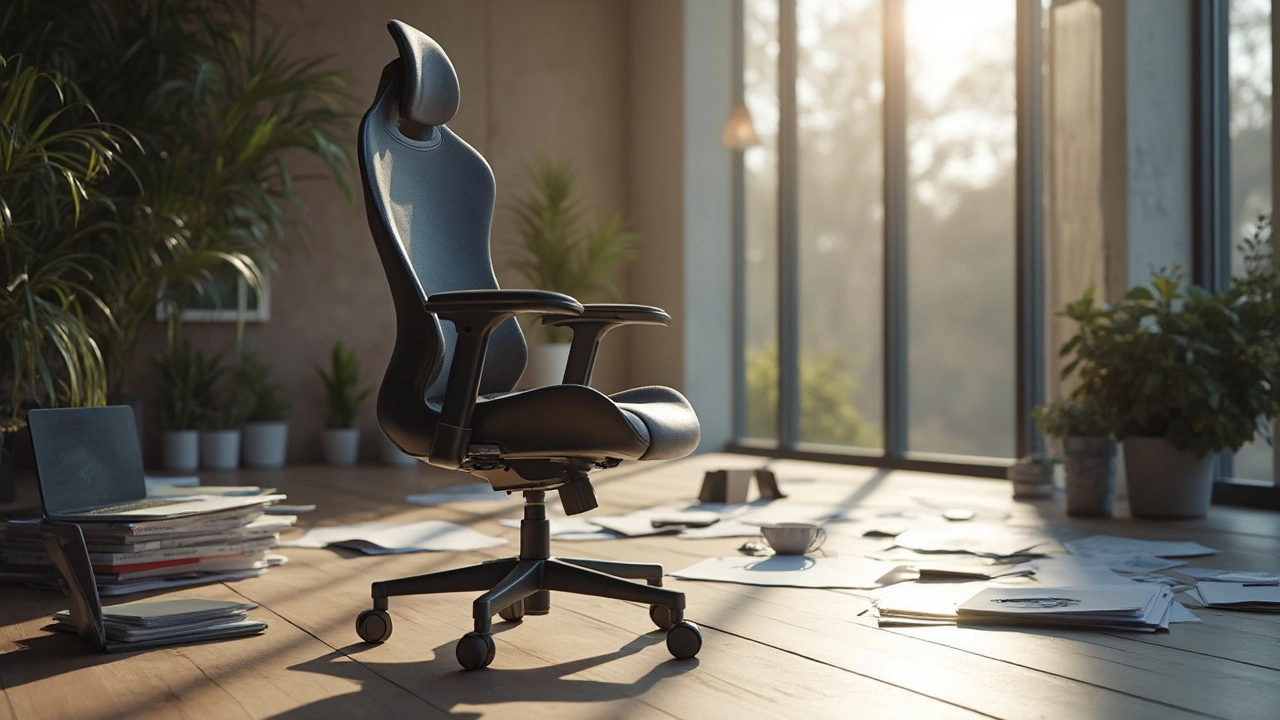 15
Mar,2025
15
Mar,2025
Choosing the right office chair can make a big difference in how you feel at the end of the day. I mean, who wants to deal with back pain and neck strain after a long day at the desk? It's not just about comfort, though. The chair you spend hours in also affects your productivity and overall health.
You might wonder why ergonomics are such a big deal. It's simple: an ergonomic chair supports your body where it needs it most, reducing the strain on your spine and improving your posture. There are tons of options out there, each promising to be the best—but truth be told, not all chairs are made equal.
Let's zoom into what makes a chair truly ergonomic. Think about adjustable armrests, lumbar support, and seats that contour to your body. These are not just fancy add-ons; they are essentials for keeping you pain-free and focused during those marathon work sessions. Plus, investing in a quality chair now can save you from future chiropractor visits.
- Why Ergonomics Matter
- Features to Look For
- Popular Chair Types
- Impact on Health and Productivity
- Tips for Choosing the Right Chair
Why Ergonomics Matter
Okay, so let's talk about why ergonomics is such a hot topic when it comes to office chairs. Essentially, ergonomics is all about designing furniture that fits our bodies, not the other way around. When you're sitting properly, you can work longer without aches and pains creeping up on you.
More than 80% of people report some kind of discomfort from sitting at their desk, and bad posture is usually the culprit. The right ergonomic chair can help correct this. These chairs focus on reducing pressure on critical points, like your lower back, neck, and joints, which can really take a beating after hours at the desk.
But it's not just about avoiding pain—ergonomics can actually help you work better. Studies have shown that a well-designed chair can boost productivity by up to 17%. That's because when you're comfortable, you're less likely to be distracted by discomfort, which lets you focus on what matters.
Key Features of Ergonomic Design
- Lumbar Support: Ensures your lower back is supported, preventing slouching that can lead to long-term issues.
- Adjustable Armrests: Keeps your shoulders and arms relaxed, reducing strain on your neck and shoulders.
- Seat Height: The ability to adjust seat height is crucial for keeping feet flat on the ground or on a footrest, which helps with circulation.
This is why spending a bit more on a quality desk chair can be a wise investment. It might seem like a big decision, but the benefits to your health and work efficiency make it totally worth it.
Features to Look For
When hunting for the perfect office chair, there are key features you just can’t ignore. A great chair is like a trusty sidekick—comforting, reliable, and always got your back. So what should you be keeping an eye out for?
Adjustability
Top of the list is adjustability. No two people are exactly alike, so your chair should adjust to fit you like a glove. Key adjustments include seat height, backrest height, recline angle, and armrests. This flexibility helps ensure you stay comfy, whether you're typing away or taking a quick breather.
Lumbar Support
Your lower back will thank you for investing in good lumbar support. A slight curve that mimics the spine’s natural shape makes all the difference, preventing those pesky aches and pains.
Seat Depth and Width
Seat dimensions are super important—after all, no one wants to feel like they're perched on a tiny stool. The seat should be deep enough to support most of your thighs, but not so deep that your knees are forced into the seat back.
Material and Padding
It's worth checking if the chair comes with breathable upholstery that keeps you cool. Mesh backs are great for ventilation, while faux leather might offer a bit more style. Don’t forget the padding, though—you need enough cushion for those long work hours.
Swivel and Casters
A chair with swivel function and durable casters allows you to glide smoothly from one part of your desk to another without wrenching your back. Seriously, it saves so much time and effort.
| Feature | Importance |
|---|---|
| Adjustability | Customizes fit |
| Lumbar Support | Prevents back pain |
| Seat Dimensions | Comfort during use |
| Material | Breathability and style |
It's amazing how a few thoughtful features can transform a simple desk chair into the MVP of your office. Investing in these features will not just increase comfort but also give your productivity a pleasant push.

Popular Chair Types
Ever wondered what type of chair best suits your needs when working long hours at a desk? With so many choices, it can be overwhelming to pick just one. Let's break down some popular office chairs to give you a clearer view.
1. Ergonomic Chairs
These are all the rage for a reason. Ergonomic chairs focus on supporting your body’s natural posture, providing benefits that keep the aches and pains at bay. With features like adjustable seat height, lumbar support, and even reclining capabilities, these chairs are designed for maximum comfort and efficiency.
2. Standing Desk Chairs
If you're using a standing desk and you're looking to mix things up, a standing desk chair might be your go-to. These chairs allow you to stay active even while sitting. They're typically height-adjustable and often have a swivel base, allowing for more dynamic movement.
3. Executive Chairs
Think of executive chairs as the luxury cars of the office chair world. They’re plush, provide excellent support, and usually have high backs. While they're great for comfort, they might not offer the same level of ergonomic customization other chairs provide, so choose wisely.
4. Mesh Chairs
Here's another common option: mesh chairs. Known for their breathable and flexible back support, these chairs help keep you cool. Most come with adjustable features, making them both practical and comfy, especially in warmer work environments.
5. Ball Chairs
Feeling adventurous? Ball chairs can be a fun and functional option. These chairs are essentially exercise balls designed for sitting. They encourage active sitting, engaging your core muscles, and help improve your posture.
Choosing between these options centers on what fits your work habits and physical needs best. Whether it's being able to adjust seat height or needing advanced lumbar support, each chair type has its own set of benefits to consider.
Impact on Health and Productivity
Let's be real—spending hours at a desk can take a toll on your body. Back pain, neck tension, and even wrist discomfort are common complaints among those glued to office chairs. But here's the kicker: the right office chair can significantly reduce these issues and keep you functioning at your best.
Health Benefits
Studies have shown that an ergonomic setup can decrease musculoskeletal problems by up to 61%. A chair with good lumbar support helps maintain the natural curve of your spine, minimizing the risk of back issues. Adjustability is key here. Chairs need to adapt to different body shapes and sizes, so features like adjustable seat height and armrests are not just perks—they're necessities.
An ergonomic chair also encourages you to sit correctly. This can improve circulation, reduce fatigue, and decrease the chance of developing chronic pain. Simply put, you're less likely to feel like you've been hit by a truck after a day's work.
Boosting Productivity
Now, onto productivity. Being comfortable is more than a 'nice-to-have.' When you're parked in a supportive chair, you're less distracted by discomfort, meaning you can focus more on getting stuff done. It's a win-win.
Incorporating ergonomic designs at the workplace has been linked to a 10-15% boost in productivity. When you're not fidgeting or frequently adjusting to relieve discomfort, you stay on task longer. Those minutes add up, saving time and increasing your output.
| Factor | Potential Improvement |
|---|---|
| Ergonomic chair usage | 61% reduction in musculoskeletal issues |
| Workplace productivity | 10-15% increase |
So, the bottom line is this: investing in the right desk chair is an investment in both your health and your efficiency. Do yourself a favor and sit in something that keeps you upright and focused, not slouched and suffering.

Tips for Choosing the Right Chair
Picking the perfect office chair isn't just about what's trendy or what matches your desk. It's all about comfort, support, and functionality. Here's a lowdown on choosing the right chair to keep you comfy and productive.
Try Before You Buy
If possible, test a few chairs. Sit in them, adjust their settings, and see how they feel after a few minutes. It can be surprising how much difference a good fit can make to your workday.
Essential Features
- Adjustability: A top-notch ergonomic chair should let you adjust the seat height, armrests, and backrest. Being able to tweak these settings ensures that your chair supports your unique shape and posture.
- Lumbar Support: Check for good lumbar support that keeps your lower back's natural curve intact. This support helps in beating back pain and strain.
- Material and Cushioning: Opt for breathable material that keeps you cool. The cushioning should be firm to provide support, but not so hard it feels like sitting on a block.
Consider Your Space
Think about your workspace size and layout. If you're dealing with tight quarters, a chair with a svelte design might be more practical. But don’t sacrifice comfy for compact size!
Budget Wisely
You don't have to blow your budget, but remember that a good chair is an investment. Spending a bit more upfront can pay off in the long run with better health and higher work output.
Check Customer Feedback
Before you hit 'buy', delve into customer reviews. Real user experiences can give insight into durability and comfort over time.
Here's a quick overview of what most folks find important in an office chair:
| Feature | Importance% |
|---|---|
| Adjustability | 95% |
| Lumbar Support | 89% |
| Comfort | 94% |
| Material | 88% |
Choosing the right desk chair is a personal journey. Remember, the ideal chair should make you feel good and keep you focused throughout the day. So, take your time, do your homework, and find a chair that hits all the right spots.




